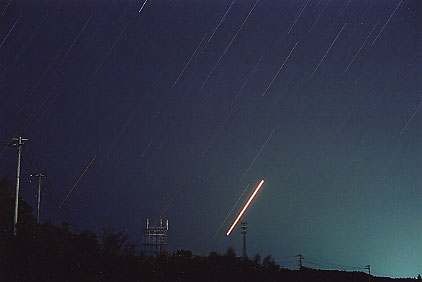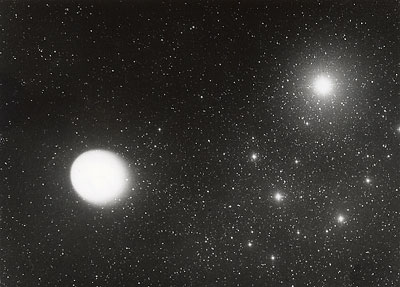November 19
Mars and Venus are bright
Comet Holmes is still visible to the naked eye in Perseus
in the northern sky. It is exciting that the comet is visible almost all
night, as it is high in the northern sky. The changes in magnitude, appearance,
and color keep me intrigued. The tail still looks like a stubby jellyfish,
but the coma continues to expand and has become faint. It has begun to
take on the appearance of fog. The photograph presented in Reports from
Geisei Observatory was taken when the comet was the most beautiful with
the translucent coma. The outline of the coma was still well-defined around
that time.
Mars is expected to make a very close approach to the earth
in late December and has become increasingly redder. It is in Gemini and
shining very brightly. Close to 5 o'clock in the morning, a little before
the beginning of morning twilight, Venus near the greatest western elongation
begins to rise, blazing magnificently with white light. Its intense brightness
distracts me from comet search.
At Geisei Observatory, we will hold a public viewing night
on December 22, which will be the last to use the 60cm reflector. For the
Winter Astronomy Class, we are planning to show approaching Mars through
the 60cm telescope. In December there will be a number of public observing
sessions with Mars being the main subject of viewing.

Mars in Gemini
5-minute exposure from 1:33, November 19, 2007
55mm f/2.8 ISO 400 film

Rising Venus
20-minute exposure from 4:20, November 20, 2007
55mm f/2.8, ISO 400 film
Autumn has deepened, while I haven't made diary entries for
some time. I searched the eastern sky this morning for the first time in
many days. Beginning with Leo, I moved to galaxy-rich Coma Berenices, then
Virgo and on to Corvus in the predawn skies. A small "Navigator"
system (digital setting circles) attached to the telescope turned out to
be effective for identifying comet-like objects coming into the eyepiece
field. I chose Polaris and Regulus in Leo, about 90 degrees apart, for
initialization. This device displayed object positions with good accuracy.
It was comparable to the accuracy achievable from sketching. I was able
to identify all the objects using the Skalnate Pleso star atlas.
While searching, I realized that the way I conduct comet
search at present would not be conducive to discovery. I sweep the sky
while simultaneously doing some other observational work such as photographic
observation. I am fully aware that, unless I concentrate only on searching,
there will be no successful discovery. I wish I could put heart and soul
into comet search, but the current multiple observation prevents me from
doing so. I dearly miss the days when I was able to think nothing but comet
discovery, pouring my youthful and pure passion into searching.
While reading mysteries of Sherlock Holmes, another Holmes
appeared in the heavens and began to behave in mysterious ways. The stories
of Sherlock Holmes are set in London. Coincidently, Comet Holmes was also
discovered in London in 1892, roughly the same time when the Holmes stories
were written. In the year of the discovery, it became unusually bright
and shined near M31 at 4th to 5th magnitude. Is this comet intrinsically
bright? Had it faded and remained faint for 100 years since the discovery?
Or is it a faint comet by its nature, but on rare occasions did it brighten
enormously because of solar activity? It is not clear to me, but I think
the latter is the case. Whichever the truth is, it is exciting to conduct
search under a brightly glowing comet overhead. According to my observation
at 23.00 on November 12 with 50mm binoculars, its total magnitude was 2.6
and coma was 30 minutes in diameter. It was blue-white with the tail faintly
trailing to the northwest. It was bluish, typical of a comet, unlike a
golden color at the time of outburst. A color photograph of the comet will
be presented shortly in Reports from Geisei Observatory.
November 12
This is a photograph of 17P/Holmes taken by the 21cm Epsilon
telescope around 2 o'clock on the morning of November 11. In the photograph
the comet appears brighter than 1.8-magnitude Alpha Persei. Visually it
was 2.5 magnitude. The coma was extensive and nearly 30' in diameter, similar
to the diameter of the moon. It was a beautiful green. The tail was not
clear because most of the tail trailed behind the coma opposite of the
sun. Judging from the shape of the coma, the tail seems to extend a little
to the west. It just looks like a mysterious jellyfish floating in space.
At the end of last month, the comet rapidly brightened from
the 17th magnitude to 2nd magnitude with a huge, but puzzling eruption.
This outburst cannot be explained by reflected sunlight. Perhaps the eruption
caused the comet to emit light. The energy of the outburst is immeasurably
large. The coma has changed its colors astonishingly fast from golden to
white, then blue to green. Comets are generally fuzzy, but peculiarly the
outline of this comet is as sharply defined as that of the moon.
This comet was discovered by Holmes of London in 1892. Comet
Holmes displays many puzzling phenomena and reminds me of Sherlock Holmes
in the English detective stories. The stories are set in London and mysterious
incidents occur one after another just like Comet Holmes undergoing mysterious
changes.
This comet was recovered by Geisei Observatory in 1992. It
was just faint without any changes in brightness. This year's return is
the 17th since the first appearance 115 years ago.
I will show you the color image of this rapidly changing
comet in the next diary entry. The changes this comet has undergone are
the first in the history of my comet search and will be recorded securely
in "Detective Tsutomu Seki's Diary of Investigation of Comets."

Comet Holmes near Alpha Persei
17P/Holmes
19-minute exposure from 2:16, November 11, 2007
ε210 21cm f/3 reflector
TX400 film



